Abstract
Extremely hard-hit areas face frequent secondary geological hazards and difficulties in vegetation recovery, and subsequent effects have a significant impact on land cover changes. At present, there is a lack of research on the dynamic restoration of, and changes in, the ecological environment before and after an earthquake, and especially a lack of quantitative assessment of the impact of earthquakes on land cover at the microscopic scale of spatial distribution of landscape indices. Taking the Lushan earthquake in Sichuan Province as an example, this paper obtained land cover data from the study area between 2012 and 2020, and analyzes the spatial distribution characteristics and influencing factors of land cover change frequency by using a comprehensive land cover degree index, land cover transfer matrix and landscape ecology index. The results show that the types of cropland, forest, built-up and bare land have changed significantly in the study area. During the earthquake recovery period, the comprehensive land cover index of the study area showed an increasing trend, and land cover has been continuously improved under the effect of artificial measures and natural restoration. After 2013, patch density (PD) and landscape shape index (LSI) values decreased and aggregation index (AI) values increased for the vast majority of landscape land classes, indicating a benign ecological development across the region in the post-earthquake period. The research results are not only helpful to establish scientific ecological environmental management in the earthquake-stricken areas, but also helpful to formulate medium- and long-term ecological environmental monitoring and ecological restoration plans based on land cover change patterns.
1. Introduction
With socio-economic development and accelerated urbanization, the study of land cover/use change is of increasing interest to scientists [1,2]. The occurrence of natural disasters has led scholars to focus more attention on the effects of land cover change and extreme hydrology (i.e., floods, river dams, mine outbursts, etc.) and extreme hazards [3,4,5]. One of these extreme hazards, earthquakes, will lead to regional land cover change and a decline in biodiversity, as well as a rapid increase in soil erosion and resource consumption, which will severely damage the ecosystem [6,7,8,9]. Research on land cover change and restoration in earthquake-affected areas is of great scientific significance for the restoration and reconstruction of natural ecosystems, the construction of human settlements and the sustainable socio-economic development of the affected areas [10]. Ecosystem change can be measured by land cover spatial-temporal evolution and landscape pattern, which are two key indicators for dynamic monitoring of post-disaster ecological restoration [11,12]. Therefore, when analyzing the amount of damage caused by disasters and how the physical characteristics of the region change over time, it is necessary to accurately monitor the change in land cover, which can provide a more scientifically sound basis for post-disaster land cover.
Remote sensing, as the main means of data acquisition in the field of earth observation, has the advantages of fast and real-time, large coverage area, rich information, not being limited by ground conditions, easy access to images, etc. It provides rich image data and detailed information, which can meet the data requirements of different research scales [13], and has become an important technical means and method in the fields of geology, ecology and seismic hazard research [14,15,16,17]. Remote sensing data shows significant advantages due to its spatial-temporal continuity and regional coverage, which can effectively reveal the changes of land cover in earthquake-stricken areas, and provide basic data support for earthquake disaster early warning, ecological environmental restoration and earthquake risk assessment. It is a currently reliable technical means and data source [18].
Following the Lushan earthquake, with m7.0, which occurred on 20 April 2013 and damaged the land cover in the region, some scholars began to pay attention to the evolution of secondary hazards in the affected areas and their impact on land cover changes, and carried out a series of research work from different perspectives. For example, Nath et al. [19] analyzed the changes of land use in Dujiangyan City from 2007–2018 from the perspective of environmental risk assessment, and found that construction land, cropland and forest land were the most affected land types, and suggested that future urban construction and development should avoid fault active areas. Cui et al. [20] studied the mechanism of the Wenchuan earthquake and conducted statistical analysis of landslides after the earthquake. It was found that loose material generated by the earthquake was the main material source of debris flow activities after the earthquake, and strong surface disturbance and extensive vegetation destruction could exacerbate erosion and flood crest formation. Wang et al. [21] fully considered the dynamic change process of vegetation restoration from the perspective of vegetation coverage and defined the COI index to identify difficult areas of vegetation restoration by using NDVI time series. Zhong et al. [22] investigated vegetation restoration on landslides after the Wenchuan earthquake and found that vegetation recovery was significantly influenced by topographic factors, particularly elevation and slope. The above studies mainly focused on the mechanism of earthquake occurrence, the distribution of geological hazards such as landslides and cave-ins, and the risk assessment of seismic hazards, etc. Some scholars also use remote sensing technology to assess the impact of ecosystem services and carrying capacity in earthquake-affected areas [23,24,25]. However, the current research gap is that most studies focus on one aspect of post-earthquake vegetation recovery, with few scholars using remote sensing imagery to target detailed studies of changes in land cover patterns before and after earthquakes, and there is a lack of quantitative long-term refinement of analysis at the microscopic scale of landscape patterns.
The objective of this study is to use time series remote sensing imagery data to reveal what the patterns of earthquakes on land cover change are, not only in terms of overall analysis of changes in land cover types, but also in terms of analysis of intra-regional differences in the effects of earthquakes on land cover landscape patterns through the Landscape Pattern Index. This paper takes the earthquake-hit Lushan County of Sichuan Province as the study area and, based on land cover data before and after the earthquake obtained by remote sensing technology and other auxiliary data, the spatial and temporal evolution characteristics of land cover in Lushan County before and after the earthquake are analyzed in a comprehensive manner from the perspective of land cover, land cover transfer matrix and landscape index, for quantitative assessment of landscape patterns in landscape ecology, and explores the driving mechanisms affecting land cover changes. The research results not only provide data support for the remote sensing dynamic monitoring of the ecological environment in the earthquake-affected areas, but also provide timely and effective data on land cover changes in the affected areas for the relevant national decision-making departments, facilitating the formulation of response guidelines and measures by the state and management departments, improving the efficiency of government regulation of land resource use, and promoting the monitoring and restoration process of the ecological environment in the earthquake-affected areas.
2. Materials
2.1. Study Area
Lushan County (30°01′ N~30°49′ N, 102°52′ E~103°11′ E) is located in Ya’an City, Sichuan Province, China, in the transition zone between the Sichuan Basin and the Qinghai-Tibetan Plateau [26]. It is bordered by Wenchuan to the north, Chongzhou and Dayi counties to the northeast, Qionglai to the east, Yucheng district to the south, Tianquan County to the southwest and Baoxing County to the northwest, with a total area of 1191.14 km2. The topography of Lushan County slopes from northwest to southeast, with a relative elevation difference of over 4000 m and an average elevation of over 2000 m. The hills of Lushan County are relatively steep and undulating, and the changes in elevation affect the distribution of plant communities, resulting in different types of plant belts. The climate of Lushan County belongs to the mid-latitude inland subtropical humid climate with four distinct seasons, an average annual temperature of 15.9 °C, an average precipitation of 1276.7 mm, an average of 887.2 h of sunshine, an average of 331 d of frost-free days and rainfall mainly concentrated between May and September each year. At 8:02 on 20 April 2013, a 7.0 magnitude earthquake occurred in the region. This earthquake occurred on the Front Range Fault Zone of the Longmen Shan Seismic Zone, which has some correlation with the Wenchuan 5·12 earthquake. The geographical location of the study area is shown in Figure 1.
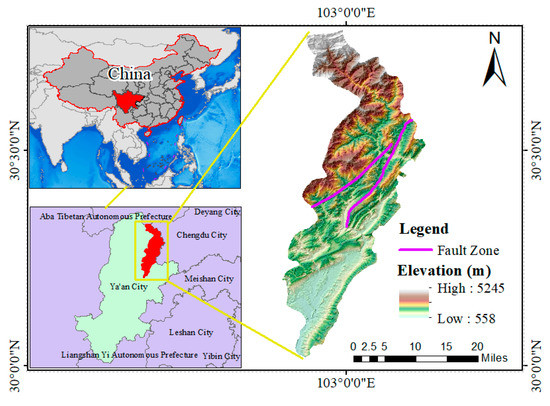
Figure 1.
Location of the study area.
2.2. Data and Preprocessing
The land cover data (pre-earthquake (2012), earthquake year (2013), mid-earthquake recovery (2015), and late earthquake recovery (2020)) used in this study are obtained from 30 m annual land cover data for China produced by Professor Huang Xin’s team at Wuhan University [27] (https://zenodo.org/record/4417810#.Yrpa8b1BxPZ, accessed on 9 January 2022). The data were based on 335,709 views of Landsat imagery on Google Earth Engine (GEE), combined with adequate, well-described and compatible training samples of existing land cover products and visually interpreted samples, and a random forest classifier was used to obtain the classification results. The random forest algorithm proposed by Breiman [28] in 2001 is a classification algorithm that consists of multiple cart decision trees, in which two parameters, the number of generators and the number of randomly selected features, are crucial to the classification result, and the algorithm determines the final category through a voting mechanism. The WGS UTM projection was used as the reference framework for the analysis of this paper after obtaining the land cover data of four periods. Figure 2 shows the land cover data of each period covering the study area.
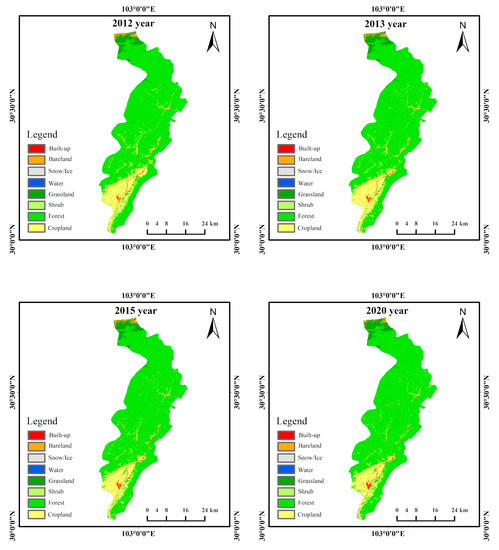
Figure 2.
Spatial distribution of land cover in the study area by period.
Confusion matrices are a common method of accuracy evaluation, as they are used to calculate the consistency of the classification results of a sample with the true category of the ground surface in the form of a matrix [29,30]. The confusion matrix allows the derivation of relevant metrics to evaluate overall and category-specific accuracy, including overall accuracy (OA), cartographic accuracy (PA), user accuracy (UA) and Kappa coefficients [31].
where is the correctly classified pixel number of type i; n is the total pixel number in the study area; is the total pixel number of type i in the data to be verified; is the total pixel number of type i in the reference data; r represents the number of rows in the confusion matrix; and N is the total number of sample points.
In order to verify that the obtained land cover data can meet the research needs, this paper collects sample points of the corresponding period based on Google Earth (Figure 3), and then evaluates the accuracy of land cover data for each period based on the confusion matrix. Table 1 shows the results of the accuracy evaluation. The study shows that the overall accuracy of land cover data for all four periods is above 80% and the kappa coefficients are above 0.70. According to the classification accuracy relationship corresponding to different Kappa values [32], the accuracy of the four phases of land cover data obtained in this paper is good and can meet the research needs of this paper.
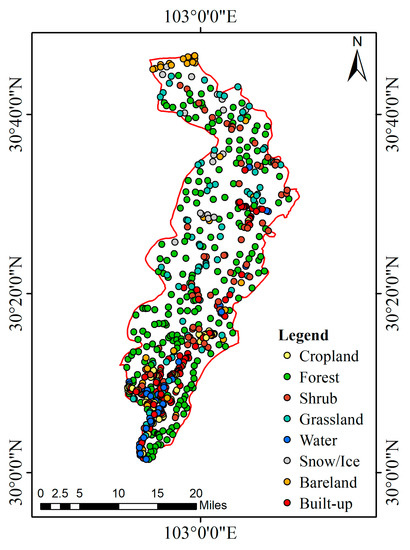
Figure 3.
Spatial distribution of validation samples in 2020.

Table 1.
Results of land cover data accuracy evaluation.
3. Methods
3.1. Composite Land Cover Index
The degree of land cover can effectively reflect the depth and breadth of land development and utilization, which includes not only changes in land cover patterns but also changes in the quantity of land cover, and fully combines the natural attribute of land resources with the social attribute of human activities [33]. The degree of land cover is a reflection of the scientific and rational nature of the land cover pattern, type, structure and layout in a certain spatial and temporal region, and also an important indicator of the quality of regional ecological environment [34]. The degree of land cover can be evaluated through the comprehensive index of the degree of land cover and its change rate. The calculation formula is as follows.
where represents the composite index of land cover extent in the study area; represents the graded index of land cover extent at level i in the study area; represents the percentage of land area at level i in the study area; represents the rate of land cover extent change; and and represent the percentage of area in level of land cover extent in the study area at time and time , respectively. If , then the land cover in the study area is in an upward development stage; if , then the land cover in the study area is in a downward decline stage. The grading of land cover is assigned with reference to the grading of land cover by Huang et al. [35] using a comprehensive analysis based on the natural stability state of the land system under the action of various other conditions, as shown in Table 2.

Table 2.
Land cover grading assignment.
3.2. Land Cover Transfer Matrix
The land cover transfer matrix not only provides the area of change in transfer from one land cover type to other land types during the year, but also provides information on the transformation within land cover between two time periods [36]. It fully reflects the transfer quantity, transfer direction and transfer probability of each category under the seismic disturbance, and is of great significance for studies such as the degree of ecological recovery in the disaster area after the earthquake. The basic expression of land cover transfer matrix is as follows.
where: represents the area of land cover type converted to land cover type j before the transfer; represents the number of land cover types; and and represent the land cover types before and after the transfer, respectively.
3.3. Landscape Ecology Index
The landscape index can quantitatively describe the structural composition and spatial configuration of the landscape, and is widely used in the quantitative description of landscape pattern. It is also an important means to quantitatively analyze the landscape pattern and its dynamic change of land cover data [37]. The impact of earthquakes and their secondary geological hazards on changes in landscape patterns is ecologically a natural disturbance, while some man-made measures in the post-disaster reconstruction process are artificial disturbances, which can cause changes to various elements of the landscape in the region under the effect of natural and artificial disturbances, thus affecting the absorption of light, water, energy and nutrients and leading to changes in the original landscape pattern. Based on the analysis of the ecological significance of the existing landscape indices, landscape pattern measurement indexes suitable for the characteristics of the study area were selected for analysis. The landscape indices selected in this paper include patch density (PD), landscape shape index (LSI) and aggregation index (AI). The ecological significance of each landscape index is as follows [38].
(1) The PD index is a measure index of landscape fragmentation, which can better reflect landscape heterogeneity. Smaller patch density corresponds to smaller landscape heterogeneity and fragmentation. In addition, the intensity and extensiveness of the interaction between landscape elements can also be indirectly reflected by the PD index. The more active the ecological processes, the higher the PD value. The PD calculation formula is as follows.
where represents the total number of patches in the landscape; and represents the total landscape area.
(2) The Landscape Shape Index LSI. The LSI is mainly a landscape index to describe landscape pattern characteristics based on the shape of the landscape. The simple shape of the landscape means that the LSI value is close to 1. If a square can be used to describe the landscape shape, the LSI value is 1. If the deviation of the landscape shape from the square is greater, the LSI value is greater. The LSI calculation formula is as follows.
where represents the total length of all patch boundaries in the landscape; and represents the total landscape area.
(3) The Aggregation Index, AI. This is an important indicator of landscape heterogeneity in terms of the level of connectivity between landscape patches. A small AI value indicates that patches in the landscape are discrete and fragmented. AI is calculated using the following formula.
where represents the number of similar connections between pixels of patch type .
In order to visually analyze the spatial variation of landscape indices in the earthquake-affected areas in four periods from 2012 to 2020, the grid analysis method was applied to study the intra-regional differences of landscape indices. The specific operation is to divide the land cover data of the study area in different periods into a 900 m × 900 m grid, then calculate the landscape index of the grid in different periods, and finally obtain the spatial distribution map of the landscape index of the study area in different periods.
3.4. Fracture Zone Buffer Analysis Method
In order to study the influence of the Shuang Shi-DaChuan fault zone on land cover change in the study area, 15 km is the maximum influence range of the fault zone on land cover change around the study area. A buffer is established every 5 km, and three buffers are established in segments. Different buffers and land cover change maps are superimposed, then the area ratio of land cover change in different buffers is counted for comparative analysis.
4. Results
4.1. Analysis of Land Cover Area Changes
Figure 4 shows the spatial pattern of land cover changes in each township before and after the earthquake. The areas with large changes in the types of croplands before and after the earthquake are mainly located in the central part of the study area. Before the earthquake, Longmen Township, Taiping Town and Baosheng Township had cropland areas of 37.59 km2, 8.53 km2 and 6.15 km2, respectively. The cropland recovered slowly after the earthquake due to the combined effects of the earthquake and human activities. By 2020, the areas of cropland in 2020 are 23.65 km2, 4.50 km2 and 2.55 km2, respectively. For forest types, the area of forest in Shuangshi Town, Feixiangquan Town, Siyan Township, Dachuan Town, Luyang Town and Chingren Township showed a decreasing trend between 2012 and 2013, and an increasing trend after 2013. In Feixiangquan Town, the largest decrease in forest type was 2.52 km2 between 2012 and 2013. For shrub types, the earthquake had a greater impact on Shuangshi Town, with the area of shrubland in the area showing a decreasing trend from 2012 to 2013. For grassland types, the area of grassland in the study area changed slightly before and after the earthquake and showed a steady trend overall. The grassland area in Dachuan Town accounted at most for more than 95% of the total area in the study area. For water types, the more significant changes are in Feixianguan Town and Dachuan Town. respectively, where the area of Feixianguan Town water type has seen an increasing trend from 2012 to 2020, increasing from 0.50 km2 in 2012 to 0.82 km2 in 2020, and the area of the Dachuan Town water type has seen a decreasing trend from 1.03 km2 in 2012 to 0.40 km2 in 2020. During 2012–2013, the water area of this town decreased by 0.26 km2 at most. Snow and ice, as a land cover type in the region, are distributed year-round in Dachuan Town and the area changes little before and after the earthquake. The bare land is mainly distributed in Dachuan Town, and there is a decreasing trend in the area of bare land during the study period. The change in the area of built-up land reflects the change of human activities. Before the earthquake, the economy of the study area was in a phase of rapid development, and the population was gradually increasing, and the area of built-up in the study area was generally on the increase. However, after the earthquake, due to the large number of residents to be resettled and the combined impact of economic development needs, the built-up area had surpassed the pre-earthquake level by 2020.
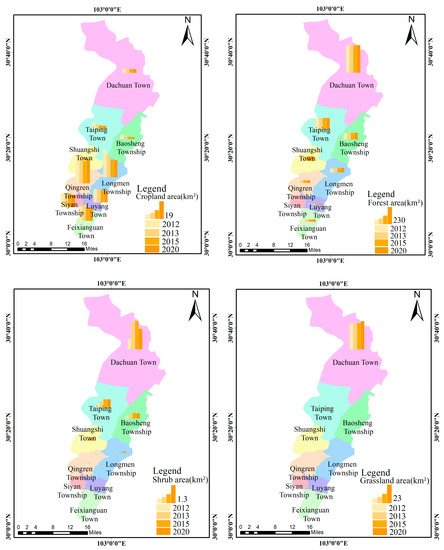
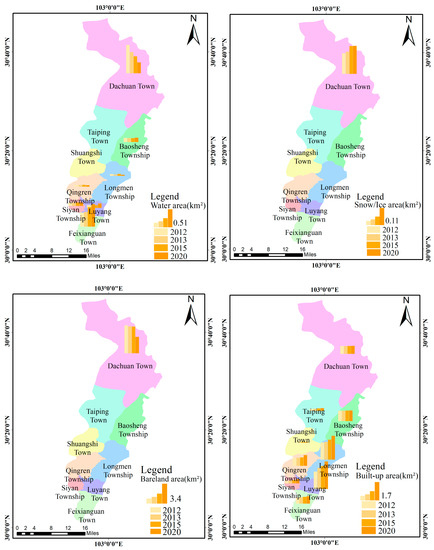
Figure 4.
Spatial distribution of land cover area changes before and after the earthquake.
4.2. Analysis of the Extent of Mutual Land Cover Transfers
As can be seen from Table 3, the impact of the Lushan earthquake on land cover change in the study area during the period 2012–2013 was mainly manifested by a large transfer out area of cropland with an area of 15.54 km2, closely followed by forest land with an area of 10.63 km2. The transfer in area of forest land type was higher, at 15.28 km2.

Table 3.
Table of land cover transfer matrix for the study area, 2012–2013. Unit (km2).
As can be seen from Table 4, the total change of land cover in the study area from 2013 to 2015 was 25.07 km2. The change of land cover during this period was mainly characterized by a large transfer of cropland and a large transfer of forest, with 93.73% of the cropland transferred to forest and 97.99% of the forest transferred to cropland. The large transfer of cropland was due to the landslides caused by the Lushan earthquake, which damaged a large amount of cropland, while the change in forest type was a twofold effect, with landslides damaging forest on the one hand and some forest becoming cropland on the other.

Table 4.
Table of land cover transfer matrix for the study area, 2013–2015. Unit (km2).
As can be seen from Table 5, the regional ecological environment has been restored to a certain level over time during the period 2015–2020, with a total land cover area transferred out of the study area of 43.50 km2. This period mainly consists of the post-earthquake recovery phase, with changes in land cover mainly manifested in the conversion of cropland into forest and built-up areas, with the area transferred out of cropland accounting for 45.70% of the total area transferred out. This result shows that over time, with the implementation of human reconstruction measures and the restoration of the natural environment, land cover in the city of Lushan has continued to improve and the ecological environment as a whole is becoming better.

Table 5.
Table of land cover transfer matrix for the study area, 2015–2020. Unit (km2).
4.3. Analysis of Changes in the Extent of Land Cover
Figure 5 reflects the spatial pattern distribution of land cover degree before and after the earthquake at the township scale in the study area. Although there was little difference in the distribution range of the comprehensive intensity index of land cover in the four periods, the change in its value showed first am decreasing, and then an increasing trend. The high index area, mainly located in the southern part of Lushan, is Siyan Town, where the combined land cover intensity index is mostly above 280. The township with the lowest combined land cover intensity is Dachuan Township, with a combined land cover intensity index of around 200.
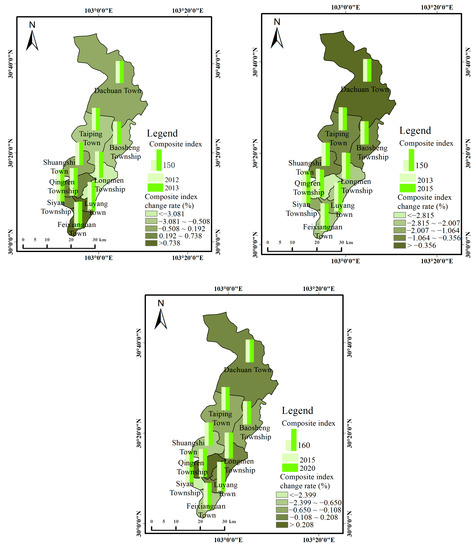
Figure 5.
Spatial distribution of land cover changes before and after the earthquake.
During the period 2012–2013, due to the Lushan earthquake and secondary land disasters, the comprehensive index of land cover degree in most townships decreased by varying degrees, and land cover entered a declining stage, mainly concentrated in the more severely affected areas such as the middle part of the study area, with the greatest decrease being in Longmen Township, where the rate of change was −3.08%. Due to the geological disaster, some of the forests and grasslands were destroyed and converted into bare land with a low utilization degree, which led to the reduction in the land utilization degree. The regions that experienced a greater degree of decline between 2013 and 2015 were Longmen Township, Feixianguan Township and Qingren Township, with changes of −2.01%, −2.20% and −2.82%, respectively. During the period 2015–2020, with reduction in bare land and post-earthquake recovery and construction, the land cover degree index of all townships has rebounded, with some townships even exceeding the pre-earthquake level, mainly due to the increase in the area of land for construction and the reduction in the area of bare land, the natural recovery of vegetation and the construction of urbanization, all of which are conducive to the increase in land cover. Among these, Qingren Township have the highest rate of change, with rates of change of 1.53%, and these townships are located in the central and southern part of the study area. This is of great help for recovery and construction after the earthquake.
4.4. Analysis of the Spatial and Temporal Evolution of the Landscape Pattern
4.4.1. Time-Varying Characteristics of Landscape Indices
Figure 6 shows the temporal trends of the landscape patch density index before and after the earthquake. Compared with 2012, the PD of cropland, shrubland, water, bare land and built-up areas in the study area first increased and then decreased after the earthquake. The PD of forest showed a downward trend, which was mainly related to human disturbance. The main reason was that engineering and residential continued to increase and occupy a large amount of forest during post-earthquake reconstruction, and the destruction of forest by the earthquake had created a large amount of bare land. The PD of grassland and snow/ice first decreased, and then increased.
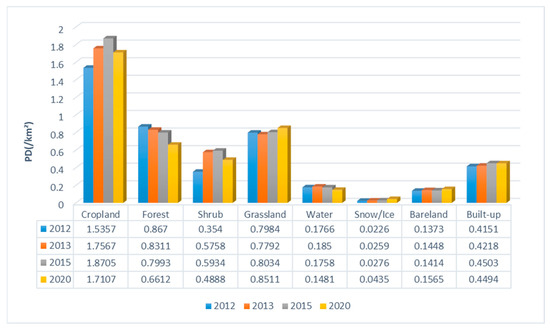
Figure 6.
Temporal trends in landscape patch density indices before and after the earthquake.
Figure 7 shows the temporal trends of landscape shape indices before and after the earthquake. After the earthquake in 2013, the LSI indices of each landscape type increased compared with that in 2012, among which the LSI values of cropland, forest, shrubland and bare land first increased and then decreased, indicating that the earthquake and secondary geological hazards led to the complex shape of this regional landscape, while reflecting a greater intervention from human activities. The LSI values of grassland and water have been on a decreasing trend, with the complex shape of the landscape gradually returning to a simple condition, while the LSI values of snow and built-up areas are on an increasing trend, probably due to the destruction of built-up areas and the complex shape of the landscape caused by the earthquake, and the construction of housing facilities such as resettlement houses after the earthquake has led to a gradual increase in the LSI values of built-up areas.
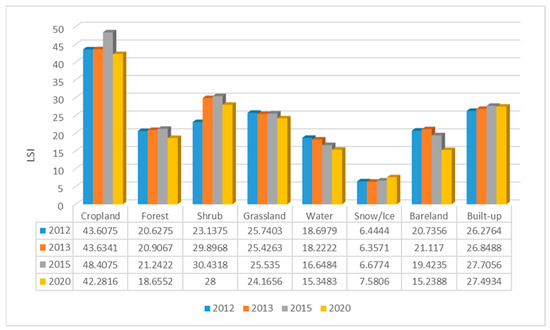
Figure 7.
Temporal trends in landscape shape indices before and after the earthquake.
Figure 8 shows the temporal trend of the landscape aggregation index before and after the earthquake. The pre-earthquake forest in the study area had the greatest aggregation, at 98, dominating the aggregation index for the entire region. The AI values of cropland, water and bare land first decreased and then increased, indicating that the connectivity between landscape patches was low and patches were more discrete in the pre-earthquake period, and that the increase in the aggregation index of bare land and water was significant in the post-earthquake period, being two landscape types subject to areas of strong human modification activities, showing that artificial restoration measures of ecological environment recovery has a positive effect. The AI values of forest maintain a stable and unchanging trend, while those of shrubland, grasslands and built-up areas maintain an increasing trend, which indicated that the ecological environment of the whole region developed in a benign direction during the latter part of the earthquake.
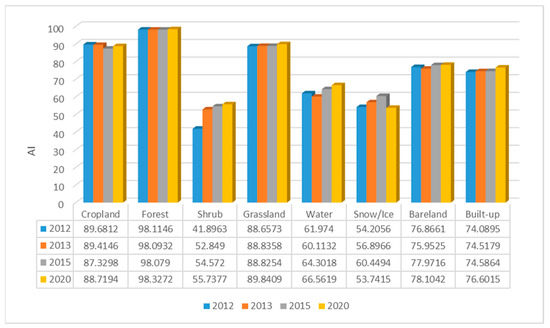
Figure 8.
Temporal trends in landscape aggregation index before and after the earthquake.
4.4.2. Spatial Variability Characteristics of Landscape Indices
Figure 9 shows the spatial pattern distribution change of landscape patch density before and after the earthquake. The higher values of PD before the earthquake are mainly located in the northern and southern parts of the study area. After the earthquake in 2013, the maximum PD showed a decreasing trend, with the area of spatial change concentrated in the south-western part of the study area, and the landscape pattern distribution changed less overall, indicating that the degree of regional landscape fragmentation and landscape heterogeneity caused by the earthquake gradually decreased, which is closely related to the large number of production and construction activities carried out in the late earthquake recovery period.
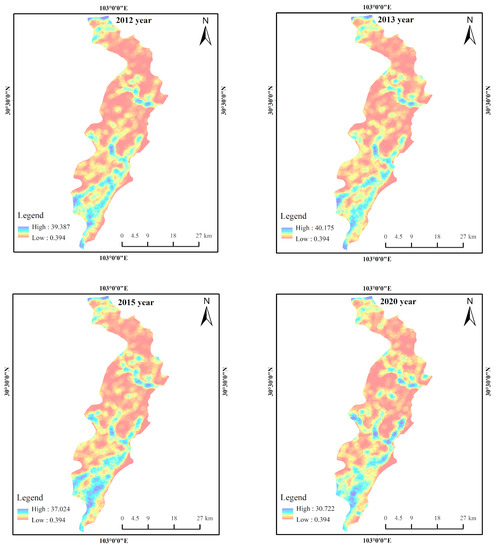
Figure 9.
Spatial distribution of the PD Landscape Index 2012–2020.
Figure 10 shows the spatial change pattern distribution of landscape shape index before and after the earthquake. The higher values of the pre-earthquake LSI are mainly located in the southern and northern parts of the study area. After the 2013 earthquake, the maximum value of LSI showed a decreasing trend, and its spatial variation was concentrated in the southern part of the study area, indicating that the overall recovery of regional landscape shape complexity was poor after the earthquake, and the landscape shape was only slightly more complex in the southern part of the study area, which may be due to the large population there, the strong human reconstruction activities and the complex land cover types in the region, which made the ecological environment recover more slowly.

Figure 10.
Spatial distribution of the LSI Landscape Index 2012–2020.
Figure 11 shows the spatial change pattern distribution of the landscape aggregation index before and after the earthquake. The lower values of AI before the earthquake were mainly distributed in the southern part of the study area. After the 2013 earthquake, the minimum AI values showed a trend of gradual increase. From 2012 to 2020, the change of AI value was mainly concentrated in the south-central part of the study area. The surface landscape was more complex and greatly disturbed by human activities, which led to a slower recovery of the aggregation index in the affected areas covered by the earthquake and its secondary geological hazards.

Figure 11.
Spatial distribution of AI Landscape Index 2012–2020.
4.5. Fracture Zone Buffer Zone Land Cover Change Results
This paper analyzes the spatial and temporal evolution of land cover in the earthquake-hit Lushan County before and after the earthquake, based on remote sensing. The above experimental results showed that the land cover of Lushan County exhibits destructive deformation characteristics not only at the macroscopic scale, but also at the microscopic scale of the spatial distribution of landscape indices, which is inseparable from the influence of natural conditions in the study area.
Based on the existing research results [39,40,41], this paper quantifies the land cover change patterns before and after the earthquake in the 5 km, 10 km and 15 km areas of the Shuang Shi-Dachuan fault zone in the study area (Figure 12). From the statistical results, it can be concluded (Figure 13) that land cover change within 5 km of the Shuang Shi-DaChuan fault zone is 17.64% of the total land cover change area, mainly distributed in the southwest of the study area. The percentage of land cover change area within 5–10 km of the total land cover change area is 17.34%, mainly distributed in the south of the study area. The percentage of land cover change area within 10–15 km of the total land cover change area is 17.02%, mainly distributed in the southern part of the study area. The percentage of land cover change area within 15 km of the total land cover change area is as high as 52%. The results shows that the amount of land cover change influenced by the Shuang Shi-Dachuan fault zone is higher in the area closer to the Shuang Shi-Dachuan fault zone, and the degree of land damage is more serious.
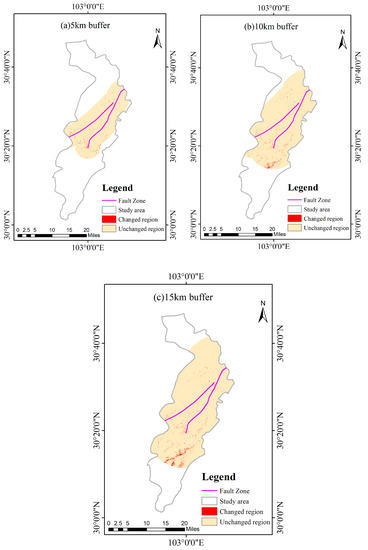
Figure 12.
Spatial distribution of land cover change around the Shuang Shi-Dachuan Fracture Zone (2013–2015).
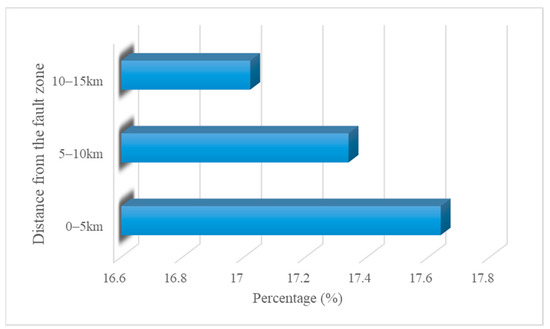
Figure 13.
The percentage of land cover change area in different buffer zones in the total change area of Shuang Shi-DaChuan fault zone (2013–2015).
5. Discussion
5.1. Analysis of the Interaction between Land Cover Change and Seismic Hazards in Earthquake-Affected Areas
The analysis of the results in Section 4 reveals that forest is the dominant land type in the Lushan area and determines the overall ecological quality. The forest area of the six townships in the study area showed a decreasing trend, with Feixiangquan Township showing the largest decrease of 2.52 km2 between 2012 and 2013, which was due to the shift from forest land cover to other land cover types caused by the earthquake and its secondary hazards such as landslides. Moreover, the comprehensive index of land cover degree in most towns has been reduced by different degrees. The percentage of land cover change within the 15 km buffer zone of the Shuang Shi-Dachuan Fracture Zone in the study area during 2013–2015 exceeded 50% of the total land cover change area, due to the extrusion and expansion of the fracture zone, which had a large impact on the land cover around the fracture zone, where the huge energy released destroyed the vegetation at higher elevations and left the ground surface bare, resulting in an increase in the land cover type visually manifested as the bare land type.
The results of the Land Cover Landscape Index for the period 2015–2020 show that the earthquake recovery period in the Lushan area has been good. The degree of landscape fragmentation was gradually reduced, landscape heterogeneity was reduced, the connectivity between landscape patches was high, and the ecological environment was significantly improved. This is due to the fact that the study area is in a humid/semi-humid climate zone with a wetter climate, and the high rainfall in the area after the Lushan earthquake has led to a faster recovery of the forest cover type in the hilly area, which has resulted in a gradual development of a good land cover environment in Lushan.
In addition, slope gradient is an important factor in the recovery process of landslides and subsequent surface cover types, especially vegetation [42,43]. Previous studies have shown that slope gradients in the range of 20–50° are most susceptible to landslides [44,45], which indicates that seismic disturbance of surface vegetation is mainly manifested as landslides.
5.2. Analysis of the Impact of Human Factors on Land Cover Change in Earthquake-Affected Areas
The influence of policy on land cover change is obvious. Government policy guidance is an important factor in land cover change, which can guide changes in economic structure, thus indirectly influencing the intensity and pattern of land cover [46,47]. The influence of the government’s decision-making actions on land cover change is reflected in two main aspects: on the one hand, the rationalization of the structure of agricultural production, according to the specific situation of the local area, cash crops such as coffee and cocoa beans being the main object of development. In this way, some of the cropland is shifted to other types of agricultural production, and in the process of land cover change the type of cropland has also gradually shifted to forest land types, etc. On the other hand, administrative decisions by the government (e.g., building railways, highways, etc.) have led to changes in the means and extent of land cover [48,49].
The impact of socio-economic development on land cover change is equally non-negligible. Socio-economic development is one of the main causes of land cover change. Economic development is accompanied by growth in land types such as built-up areas and cropland, which inevitably affects changes of land cover structure [50]. Post-disaster restoration and reconstruction should take full account of the ecological characteristics of the earthquake-stricken areas of Lushan, take reconstruction as an opportunity to actively develop ecological industries, gradually transform traditional agriculture into ecological agriculture, and firmly follow the path of ecological industry base construction. The eastern part of the disaster area is the main concentration area for industrial development. The construction of eco-industrial parks should be strengthened, with advanced, green and intelligent industries as the main focus, and state policy support should be strengthened to promote the upgrading and transformation of existing industries. The central and western regions should be dominated by eco-agriculture and eco-tourism, and different construction priorities and models should be gradually developed, taking into account differences in location conditions, development bases and functional positioning.
Therefore, it is of long-term social significance to make full use of the opportunities for post-quake reconstruction in Lushan, based on the results of the “Assess: scientific planning, optimizing the spatial layout of towns in the earthquake zone, guiding the withdrawal of villages and towns threatened by mountain disasters, dealing with poor transportation and infrastructure conditions and those which too small in scale, strengthening the construction layout of central villages and towns, and making towns develop from scattered to grouped, so as to enhance the sustainable development of land cover in the disaster zone.
5.3. Advantages and Limitations of Remote Sensing Monitoring in Disaster Environmental Change Assessment
The use of remote sensing means can quickly grasp the basic information such as the spatial distribution of land cover in the earthquake-affected areas within a short period of time, and can also carry out comprehensive analysis of the dynamic changes in the earthquake-affected areas under different time scales based on multi-period image data. The results are conducive to the dynamic monitoring and assessment of the disaster situation, and the grasp of post-disaster land cover recovery has important guiding significance for post-disaster reconstruction work. In addition, compared with the traditional manual survey method, which is time-consuming and making it difficult to obtain complete and accurate information, remote sensing combined with GIS technology has become a more effective means of monitoring earthquake areas in large regions and defining earthquake damage factors in the most affected areas [51].
However, there are some problems in using remote sensing methods to monitor environmental changes in earthquake-affected areas. For example, (1) the timeliness of remote sensing data acquisition is affected by the large amount of cloud cover in some areas of the disaster area due to the fact that the earthquake is often accompanied by other natural disasters such as rainfall and mudslides. (2) For feature categories with small differences in spectral and textural characteristics, it is more difficult to accurately classify optical remote sensing images, so the uncertainty of the classification results will lead to partial bias in the evaluation and analysis of earthquake affected areas. (3) Remote sensing technology can only identify the type of ground cover, but it cannot effectively monitor other details that are urgently needed for disaster relief and mitigation, such as the number of collapsed buildings, damaged floors, population distribution and the extent of road damage.
6. Conclusions
Based on remote sensing data, this paper used the comprehensive land cover index, land cover transfer matrix and landscape ecological index to explore and analyze the spatial and temporal evolution characteristics of land cover before and after the earthquake in the hardest-hit area of Sichuan (Lushan County). The conclusions of this study are as follows: (i) Changes in land cover types caused by seismic hazards are mainly reductions in cropland area, with most regions experiencing varying degrees of reduction in the composite index of land cover extent during 2012–2013 because of earthquakes and secondary land hazards. (ii) The transfer of land cover types caused by the earthquake is mainly the conversion of cropland to forest and built-up land, which leads to better recovery of the vegetation environment at a later stage. (iii) Human disturbance during the earthquake recovery period leads to a change in the overall landscape structure from complex to simple, with a greater variation in the proportion of each landscape type. There is less landscape fragmentation within the region, less landscape heterogeneity, more connectivity between landscape patches and a significantly better ecological environment. (iv) Land cover changes in the earthquake-affected areas are mainly located in the vicinity of the fracture zones, which is due to the diversity of landform types and the undulating topography around the zones.
The analysis of land cover change patterns in earthquake-affected areas allows for the linking of the three complementary objectives of disaster mitigation, sustainable development and resilience. Governments can use the impact of earthquakes on land cover to think about what might happen in a disaster, and then what might need to happen in terms of response and recovery after an event. They can then develop specific plans to reduce the impact of the disaster before it happens, or they can develop pre-incident plans that help with the response and recovery phases. Pre-incident recovery planning can take place within many departments or can be coordinated between them, including land use planning, emergency management, insurance providers, etc. Achieving long-term sustainability and greater resilience will require more visionary land use planning solutions. Given that the resilience and sustainability of land cover in earthquake-affected areas is so closely linked, a broader understanding of the various factors that influence the pattern of change in land cover as a result of earthquakes would contribute to surface recovery and sustainable development in earthquake-affected areas, which would be of interest in advancing the process of ecological monitoring and recovery.
Author Contributions
Conceptualization, J.W. and Z.W.; methodology, J.W.; software, J.W.; validation, J.W., J.K. and Z.W.; formal analysis, J.W.; investigation, J.K. and Z.W.; resources, J.W.; data curation, X.L.; writing—original draft preparation, J.W.; writing—review and editing, Z.W. and J.K.; visualization, J.W. and X.L.; supervision, Z.W. and H.C.; project administration, Z.W.; funding acquisition, Z.W. and H.C. All authors have read and agreed to the published version of the manuscript.
Funding
This study was supported by the National Key R&D Program of China, Grant No. 2021YFB3900501; the National Natural Science Foundation of China, Grant No. 41901354; the Innovation Project of LREIS, Grant No. O88RAA01YA; the Science and Technology Foundation of the Second Monitoring and Application Center, China Earthquake Administration, Grant No. KJ20220203, and the Science and Technology Foundation of the Second Monitoring and Application Center, China Earthquake Administration, Grant No. KJ20220104.
Data Availability Statement
The data that support the findings of this study are openly available in zenodo at https://zenodo.org/record/4417810#.Yrpa8b1BxPZ, accessed on 9 January 2022.
Conflicts of Interest
The authors declare no conflict of interest.
References
- Liu, J.; Deng, X. Progress of the research methodologies on the temporal and spatial process of LUCC. Chin. Sci. Bull. 2010, 55, 1354–1362. [Google Scholar] [CrossRef]
- Huang, N.; Wang, L.; Song, X.-P.; Black, T.A.; Jassal, R.S.; Myneni, R.B.; Wu, C.; Wang, L.; Song, W.; Ji, D. Spatial and temporal variations in global soil respiration and their relationships with climate and land cover. Sci. Adv. 2020, 6, eabb8508. [Google Scholar] [CrossRef] [PubMed]
- Rajsekhar, D.; Gorelick, S.M. Increasing drought in Jordan: Climate change and cascading Syrian land-use impacts on reducing transboundary flow. Sci. Adv. 2017, 3, e1700581. [Google Scholar] [CrossRef] [PubMed] [Green Version]
- Khan, M.M.H.; Bryceson, I.; Kolivras, K.N.; Faruque, F.; Rahman, M.M.; Haque, U. Natural disasters and land-use/land-cover change in the southwest coastal areas of Bangladesh. Reg. Environ. Chang. 2015, 15, 241–250. [Google Scholar] [CrossRef]
- Barros, J.L.; Tavares, A.O.; Santos, P.P. Land use and land cover dynamics in Leiria City: Relation between peri-urbanization processes and hydro-geomorphologic disasters. Nat. Hazards 2021, 106, 757–784. [Google Scholar] [CrossRef]
- Xiang, M.; Deng, Q.; Duan, L.; Yang, J.; Wang, C.; Liu, J.; Liu, M. Dynamic monitoring and analysis of the earthquake Worst-hit area based on remote sensing. Alex. Eng. J. 2022, 61, 8691–8702. [Google Scholar] [CrossRef]
- Cui, P.; Lin, Y.-M.; Chen, C. Destruction of vegetation due to geo-hazards and its environmental impacts in the Wenchuan earthquake areas. Ecol. Eng. 2012, 44, 61–69. [Google Scholar]
- Wang, Y.; Fu, B.; Xu, P. Evaluation the impact of earthquake on ecosystem services. Procedia Environ. Sci. 2012, 13, 954–966. [Google Scholar] [CrossRef] [Green Version]
- Renaud, F.; Murti, R. Ecosystems and disaster risk reduction in the context of the Great East Japan Earthquake and Tsunami—A scoping study. UNU-EHS Publ. Ser. 2013, 10. [Google Scholar] [CrossRef]
- Shou, K.; Hong, C.; Wu, C.; Hsu, H.; Fei, L.; Lee, J.; Wei, C. Spatial and temporal analysis of landslides in Central Taiwan after 1999 Chi-Chi earthquake. Eng. Geol. 2011, 123, 122–128. [Google Scholar] [CrossRef]
- Li, J.; Xie, X.; Zhao, B.; Xiao, X.; Xue, B. Spatio-Temporal Processes and Characteristics of Vegetation Recovery in the Earthquake Area: A Case Study of Wenchuan, China. Land 2022, 11, 477. [Google Scholar] [CrossRef]
- Xu, J.; Tang, B.; Lu, T. Monitoring the riparian vegetation cover after the Wenchuan earthquake along the Minjiang River valley based on multi-temporal Landsat TM images: A case study of the Yingxiu-Wenchuan section. Acta Ecol. Sin. 2013, 33, 4966–4974. [Google Scholar]
- Wang, J.; Yang, X.; Wang, Z.; Cheng, H.; Kang, J.; Tang, H.; Li, Y.; Bian, Z.; Bai, Z. Consistency Analysis and Accuracy Assessment of Three Global Ten-Meter Land Cover Products in Rocky Desertification Region—A Case Study of Southwest China. ISPRS Int. J. Geo-Inf. 2022, 11, 202. [Google Scholar] [CrossRef]
- Lary, D.J.; Alavi, A.H.; Gandomi, A.H.; Walker, A.L. Machine learning in geosciences and remote sensing. Geosci. Front. 2016, 7, 3–10. [Google Scholar] [CrossRef] [Green Version]
- Shirazy, A.; Shirazi, A.; Nazerian, H. Application of Remote Sensing in Earth Sciences–A Review. Int. J. Sci. Eng. Appl. 2021, 10, 45–51. [Google Scholar]
- Kerr, J.T.; Ostrovsky, M. From space to species: Ecological applications for remote sensing. Trends Ecol. Evol. 2003, 18, 299–305. [Google Scholar] [CrossRef]
- Tronin, A.A. Remote sensing and earthquakes: A review. Phys. Chem. Earth Parts A/B/C 2006, 31, 138–142. [Google Scholar] [CrossRef]
- Zhao, X.; Pan, S.; Sun, Z.; Guo, H.; Zhang, L.; Feng, K. Advances of satellite remote sensing technology in earthquake prediction. Nat. Hazards Rev. 2021, 22, 03120001. [Google Scholar] [CrossRef]
- Nath, B.; Niu, Z.; Singh, R.P. Land Use and Land Cover changes, and environment and risk evaluation of Dujiangyan city (SW China) using remote sensing and GIS techniques. Sustainability 2018, 10, 4631. [Google Scholar] [CrossRef] [Green Version]
- Cui, P.; Zhuang, J.; Chen, X.; Zhang, J.; Zhou, X. Characteristics and Countermeasures of Debris Flow in Wenchuan Area after the Earthquake. J. Sichuan Univ. (Eng. Sci. Ed.) 2010, 42, 10–19. [Google Scholar]
- Wang, M.; Yang, W.; Shi, P.; Xu, C.; Liu, L. Diagnosis of vegetation recovery in mountainous regions after the Wenchuan earthquake. IEEE J. Sel. Top. Appl. Earth Obs. Remote Sens. 2014, 7, 3029–3037. [Google Scholar] [CrossRef]
- Zhong, C.; Li, C.; Gao, P.; Li, H. Discovering Vegetation Recovery and Landslide Activities in the Wenchuan Earthquake Area with Landsat Imagery. Sensors 2021, 21, 5243. [Google Scholar] [CrossRef] [PubMed]
- Barua, S.K.; Boscolo, M.; Animon, I. Valuing forest-based ecosystem services in Bangladesh: Implications for research and policies. Ecosyst. Serv. 2020, 42, 101069. [Google Scholar] [CrossRef]
- Campbell, E.; Marks, R.; Conn, C. Spatial modeling of the biophysical and economic values of ecosystem services in Maryland, USA. Ecosyst. Serv. 2020, 43, 101093. [Google Scholar] [CrossRef]
- Friess, D.A.; Yando, E.S.; Wong, L.-W.; Bhatia, N. Indicators of scientific value: An under-recognised ecosystem service of coastal and marine habitats. Ecol. Indic. 2020, 113, 106255. [Google Scholar] [CrossRef]
- Tang, Q.; Li, Y.; Xu, Y. Land suitability assessment for post-earthquake reconstruction: A case study of Lushan in Sichuan, China. J. Geogr. Sci. 2015, 25, 865–878. [Google Scholar] [CrossRef]
- Yang, J.; Huang, X. The 30 m annual land cover dataset and its dynamics in China from 1990 to 2019. Earth Syst. Sci. Data 2021, 13, 3907–3925. [Google Scholar] [CrossRef]
- Breiman, L. Random forests. Mach. Learn. 2001, 45, 5–32. [Google Scholar] [CrossRef] [Green Version]
- Canters, F. Evaluating the uncertainty of area estimates derived from fuuy land-cover classification. Photogramm. Eng. Remote Sens. 1997, 63, 403–414. [Google Scholar]
- Clark, M.L.; Aide, T.M.; Grau, H.R.; Riner, G. A scalable approach to mapping annual land cover at 250 m using MODIS time series data: A case study in the Dry Chaco ecoregion of South America. Remote Sens. Environ. 2010, 114, 2816–2832. [Google Scholar] [CrossRef]
- Tung, F.; LeDrew, E. The determination of optimal threshold levels for change detection using various accuracy indexes. Photogramm. Eng. Remote Sens. 1988, 54, 1449–1454. [Google Scholar]
- Camps-Valls, G.; Tuia, D.; Gómez-Chova, L.; Jiménez, S.; Malo, J. Camps-Valls G, Tuia D, Gómez-Chova L, et al. Remote sensing image processing. Synth. Lect. Image Video Multimed. Processing 2011, 5, 1–192. [Google Scholar]
- Shi, G.; Jiang, N.; Yao, L. Land use and cover change during the rapid economic growth period from 1990 to 2010: A case study of shanghai. Sustainability 2018, 10, 426. [Google Scholar] [CrossRef] [Green Version]
- Gao, P.; Niu, X.; Wang, B.; Zheng, Y. Land use changes and its driving forces in hilly ecological restoration area based on gis and rs of northern china. Sci. Rep. 2015, 5, 1–11. [Google Scholar] [CrossRef] [PubMed] [Green Version]
- Hang, M.; He, X.; Wu, D. Analysis of land use extent changes and their spatial heterogeneity in the Chaohu Lake watershed. Soils 2015, 47, 994–1000. [Google Scholar]
- Shawul, A.A.; Chakma, S. Spatiotemporal detection of land use/land cover change in the large basin using integrated approaches of remote sensing and GIS in the Upper Awash basin, Ethiopia. Environ. Earth Sci. 2019, 78, 1–13. [Google Scholar] [CrossRef]
- Kupfer, J.A. Landscape ecology and biogeography: Rethinking landscape metrics in a post-FRAGSTATS landscape. Prog. Phys. Geogr. 2012, 36, 400–420. [Google Scholar] [CrossRef]
- Kang, J.; Sui, L.; Yang, X.; Wang, Z.; Huang, C.; Wang, J. Spatial pattern consistency among different remote-sensing land cover datasets: A case study in Northern Laos. ISPRS Int. J. Geo-Inf. 2019, 8, 201. [Google Scholar] [CrossRef] [Green Version]
- Wang, F.-X.; Zhou, W.-C. The Study on Land Use Changes of Wenchuan Disaster Area based on RS and GIS. In Proceedings of the 2009 2nd International Congress on Image and Signal Processing, Tianjin, China, 17–19 October 2009; pp. 1–5. [Google Scholar]
- Wang, L.; Tian, B.; Masoud, A.; Koike, K. Relationship between remotely sensed vegetation change and fracture zones induced by the 2008 Wenchuan earthquake, China. J. Earth Sci. 2013, 24, 282–296. [Google Scholar] [CrossRef] [Green Version]
- Yang, X.; Yang, W.-N.; Li, Y.-H.; Hu, B.-R. Land Use Land Cover Change Analysis after the Earthquake of Wenchuan. In Proceedings of the 2010 International Conference on Multimedia Technology, Ningbo, China, 29–31 October 2010; pp. 1–4. [Google Scholar]
- Wang, H.; Sassa, K.; Xu, W. Analysis of a spatial distribution of landslides triggered by the 2004 Chuetsu earthquakes of Niigata Prefecture, Japan. Nat. Hazards 2007, 41, 43–60. [Google Scholar] [CrossRef]
- Chang, K.-T.; Chiang, S.-H.; Hsu, M.-L. Modeling typhoon-and earthquake-induced landslides in a mountainous watershed using logistic regression. Geomorphology 2007, 89, 335–347. [Google Scholar] [CrossRef]
- Huang, R.; Li, W. Analysis of the geo-hazards triggered by the 12 May 2008 Wenchuan Earthquake, China. Bull. Eng. Geol. Environ. 2009, 68, 363–371. [Google Scholar] [CrossRef]
- Khazai, B.; Sitar, N. Evaluation of factors controlling earthquake-induced landslides caused by Chi-Chi earthquake and comparison with the Northridge and Loma Prieta events. Eng. Geol. 2004, 71, 79–95. [Google Scholar] [CrossRef]
- Hersperger, A.M.; Oliveira, E.; Pagliarin, S.; Palka, G.; Verburg, P.; Bolliger, J.; Grădinaru, S. Urban land-use change: The role of strategic spatial planning. Glob. Environ. Change 2018, 51, 32–42. [Google Scholar] [CrossRef]
- König, H.J.; Schuler, J.; Suarma, U.; McNeill, D.; Imbernon, J.; Damayanti, F.; Dalimunthe, S.A.; Uthes, S.; Sartohadi, J.; Helming, K. Assessing the impact of land use policy on urban-rural sustainability using the FoPIA approach in Yogyakarta, Indonesia. Sustainability 2010, 2, 1991–2009. [Google Scholar] [CrossRef] [Green Version]
- Chen, L.; Zhu, Y. Bridge Design Concept and Innovation of Chengdu-Dujiangyan Intercity Railway-Post Wenchuan Earthquake Reconstruction Project in Sichuan, China. In Proceedings of the 1st International Workshop on High-Speed and Intercity Railways, Shenzhen, China, 13 February 2012; pp. 205–216. [Google Scholar]
- Ou, J.; Li, H. The regional engineering damage and reconstruction strategy in Wenchuan earthquake of China. J. Earthq. Tsunami 2011, 5, 189–216. [Google Scholar] [CrossRef]
- Kim, J.H. Linking land use planning and regulation to economic development: A literature review. J. Plan. Lit. 2011, 26, 35–47. [Google Scholar]
- Contreras, D.; Blaschke, T.; Tiede, D.; Jilge, M. Monitoring recovery after earthquakes through the integration of remote sensing, GIS, and ground observations: The case of L’Aquila (Italy). Cartogr. Geogr. Inf. Sci. 2016, 43, 115–133. [Google Scholar] [CrossRef]
Publisher’s Note: MDPI stays neutral with regard to jurisdictional claims in published maps and institutional affiliations. |
© 2022 by the authors. Licensee MDPI, Basel, Switzerland. This article is an open access article distributed under the terms and conditions of the Creative Commons Attribution (CC BY) license (https://creativecommons.org/licenses/by/4.0/).